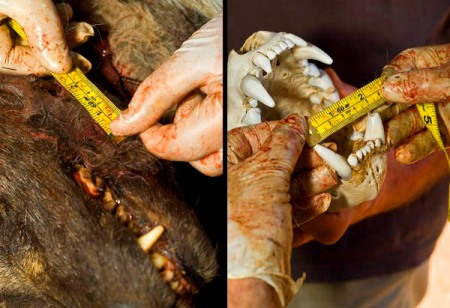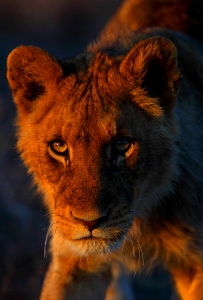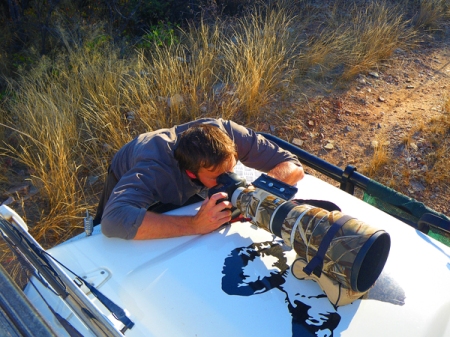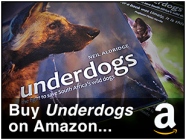 In a region bustling with development and about to welcome one of the world’s largest sporting events in the FIFA World Cup, in a continent that has just counted it’s one billionth person, it is hard to see space for the expansion of safe habitat for a pack animal like the African wild dog. But new protection and landscape-scale conservation efforts may offer hope.
In a region bustling with development and about to welcome one of the world’s largest sporting events in the FIFA World Cup, in a continent that has just counted it’s one billionth person, it is hard to see space for the expansion of safe habitat for a pack animal like the African wild dog. But new protection and landscape-scale conservation efforts may offer hope.
Wild dog packs utilise such huge areas that there are few reserves in Southern Africa big enough to home sustainable, stand-alone populations. When one or more dogs disperse to form a new pack, their reliance on safe and suitable habitat becomes even greater. Thankfully, the UN Environment Programme has made the move to upgrade the status of the species to migratory. This not only promises greater protection but also calls for further regional cooperation towards securing agreements over transfrontier conservation areas like the Greater Mapungubwe area.

The heart of the Greater Mapungubwe Transfrontier Conservation Area (TFCA) lies at the confluence of the Limpopo and Shashe rivers – the meeting point of South Africa, Botswana and Zimbabwe. If this vision of a cross-border haven can be realised then it may secure the future of the few wild dog packs living in the region. Lions, the wild dog’s greatest natural enemy, are low in numbers here but this does not mean the dogs can live without threat or fear.
 Rural communities live off the land here through necessity as well as tradition. The snares left by poachers and the diseases carried by domestic dogs used by hunters are a real threat to wild dogs, as well as the ever- busier roads transecting the habitat and a local farming and hunting community that is largely unwelcoming to carnivores.
Rural communities live off the land here through necessity as well as tradition. The snares left by poachers and the diseases carried by domestic dogs used by hunters are a real threat to wild dogs, as well as the ever- busier roads transecting the habitat and a local farming and hunting community that is largely unwelcoming to carnivores.
Despite such threats, the area has already received the vote of confidence as a safe habitat for wild dogs with the translocation of a pack from South Africa’s Marekele National Park to Botswana’s Northern Tuli Game Reserve in 2007. Since then, the pack has thrived in its Limpopo forest home with 25 pups in the last two years.
 In KwaZulu-Natal in eastern South Africa, wild dog numbers are on the increase too despite a declining international population. The region’s jewel-in-the-crown, the Hluhluwe-imfolozi Park, can boast arguably the country’s most stable population and with new packs now established on geographically isolated reserves elsewhere in the province, the new challenge facing conservationists is how to maintain the genetic balance of the population.
In KwaZulu-Natal in eastern South Africa, wild dog numbers are on the increase too despite a declining international population. The region’s jewel-in-the-crown, the Hluhluwe-imfolozi Park, can boast arguably the country’s most stable population and with new packs now established on geographically isolated reserves elsewhere in the province, the new challenge facing conservationists is how to maintain the genetic balance of the population.
 Rather than imitating natural movements by physically darting and translocating wild dogs between these reserves, Endangered Wildlife Trust officers are working with local rural communities to establish safe routes of dispersal to link isolated populations.
Rather than imitating natural movements by physically darting and translocating wild dogs between these reserves, Endangered Wildlife Trust officers are working with local rural communities to establish safe routes of dispersal to link isolated populations.
They may be subtly different yet both the proposed Greater Mapungubwe TFCA and the KwaZulu-Natal approaches to African wild dog conservation offer solutions for the future of a migratory species in a changing landscape. In both cases, those responsible for the safeguarding and development of the species will have to deal with the challenges dished out by a constricting human world. Although by engaging with local communities, landowners and farmers, it can be hoped that both processes will allow for a wider understanding and appreciation of the wild dog. Though in some areas, simple tolerance would be a victory.



























 Lions are a Wild Dog’s greatest natural adversary though and don’t need a second invitation to kill either adult dogs or pups. Having lost their alpha male and litter to Lions last year, it’s been fascinating monitoring the movement of the pack to avoid Lions, even up into inaccessible rocky areas.
Lions are a Wild Dog’s greatest natural adversary though and don’t need a second invitation to kill either adult dogs or pups. Having lost their alpha male and litter to Lions last year, it’s been fascinating monitoring the movement of the pack to avoid Lions, even up into inaccessible rocky areas.






